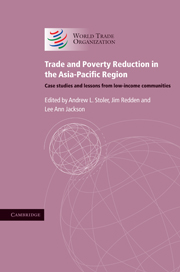 Trade and Poverty Reduction in the Asia-Pacific Region
Trade and Poverty Reduction in the Asia-Pacific Region Published online by Cambridge University Press: 05 March 2012
Introduction
Nearly 70% of the world's poor live in rural areas, and most depend on agriculture for their livelihoods (World Bank 2007b). In many poor countries, agriculture accounts for at least 40% of gross domestic product (GDP) and 80% of employment. Thus agriculture plays a potentially crucial role in poverty reduction strategies. During the Green Revolution (in the 1960s and 1970s), development and aid communities stressed the relevance of this sector as an engine of growth for countries with a high proportion of rural population. However, in the 1980s and 1990s the attention given to agricultural policies as catalysts for development and poverty reduction decreased significantly. Currently, agriculture is once again on the forefront of development debate, as recent work on the role of agriculture in development has confirmed the importance of this sector in reducing poverty (World Bank 2007b, von Braun 2007, Food and Agriculture Organisation 2005).
The set of opportunities and challenges affecting agriculture's contribution to poverty reduction have changed dramatically over the past few decades. Developing-country food demand is expected to increase over the next few decades, driven by moderate economic growth, although these increases are expected to differ across products. For example, some studies have shown that economic growth in South Asia will lead to increases of nearly 100% for meat, eggs and fish, and of 70% for milk and vegetable products (Kumar and Birthal 2007). At the same time, the resource base upon which agriculture is built will shrink due to resource degradation, climate change and competition from urban expansion. Investments in the agricultural economies of developing countries are required, but the impact of policy interventions in terms of poverty reduction will vary depending upon country-specific characteristics. One policy approach will definitely not fit all countries.
To save this book to your Kindle, first ensure [email protected] is added to your Approved Personal Document E-mail List under your Personal Document Settings on the Manage Your Content and Devices page of your Amazon account. Then enter the ‘name’ part of your Kindle email address below. Find out more about saving to your Kindle.
Note you can select to save to either the @free.kindle.com or @kindle.com variations. ‘@free.kindle.com’ emails are free but can only be saved to your device when it is connected to wi-fi. ‘@kindle.com’ emails can be delivered even when you are not connected to wi-fi, but note that service fees apply.
Find out more about the Kindle Personal Document Service.
To save content items to your account, please confirm that you agree to abide by our usage policies. If this is the first time you use this feature, you will be asked to authorise Cambridge Core to connect with your account. Find out more about saving content to Dropbox.
To save content items to your account, please confirm that you agree to abide by our usage policies. If this is the first time you use this feature, you will be asked to authorise Cambridge Core to connect with your account. Find out more about saving content to Google Drive.